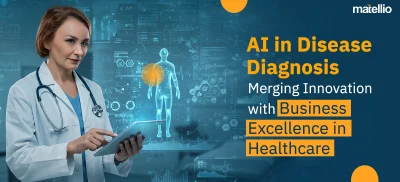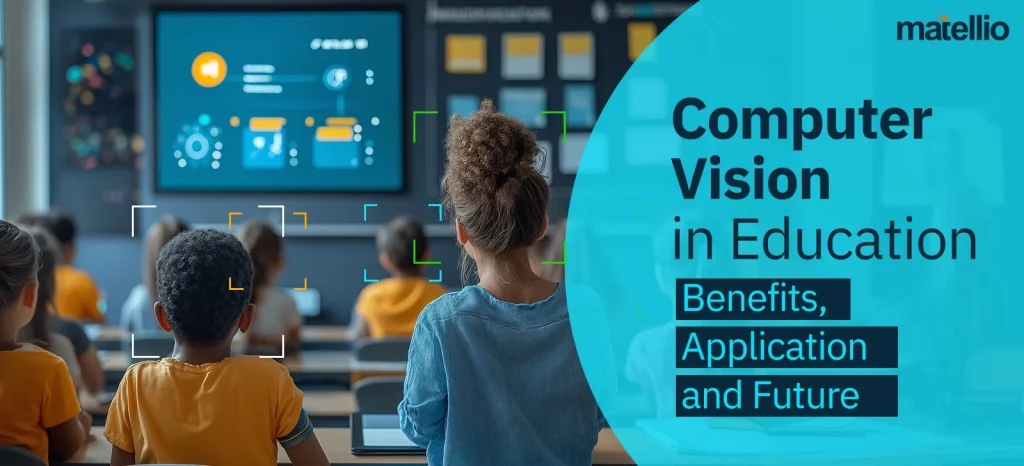
You’ve seen the change in the education industry – a sudden shift from blackboards and traditional classrooms to video-based learning modules and AR-based interactive sessions. However, while some schools are already riding the wave of innovation, many are still trying to catch up. Why? Because no one told them what’s actually possible with computer vision in education—not in theory, but in practice.
First, the numbers don’t lie. Grand View Research states that the global AI in education market is expected to grow from $5.88 billion in 2024 to $32.27 billion by 2030, with a staggering CAGR of 31.2%. That’s not growth. That’s a seismic shift.
Now let’s get real—here’s what computer vision is already doing in classrooms, lecture halls, and online learning platforms:
- Spot learning struggles instantly. Facial cues, posture shifts, and eye movements reveal confusion or disengagement in real time—boosting retention by up to 35%.
- Security that never sleeps. Real-time vision systems catch threats, trespassers, and risky behavior before humans even notice.
- Save 5+ hours a week for every teacher. From facial-recognition attendance to bias-free proctoring, schools are slashing admin time by up to 60%.
And these aren’t “nice to haves.” In a competitive education market, they’re the difference between lagging behind and leading forward.
In this blog, we’ll walk you through the hard-hitting applications of computer vision in education, the concrete ROI, and how your institution can start implementing this technology—today.
What is Computer Vision
Computer vision is a branch of artificial intelligence (yes, the smart kind) that teaches machines to “see” and understand digital images and videos—kind of like how we humans do, only with fewer coffee breaks.
In simple terms? It’s how a system looks at a classroom, a hallway, or a Zoom call and actually understands what’s going on—whether it’s spotting a distracted student, flagging an unattended bag, or detecting whether someone’s even paying attention in a virtual class.
Here’s what happens under the hood:
- It captures images or videos.
- It analyzes what it sees (think: faces, gestures, movements).
- It extracts useful insights—engagement levels, attendance, security breaches—you name it.
- It converts all that into actionable data to help you make smarter decisions faster.
This isn’t science fiction. This is computer vision in education, doing everything from personalizing learning to tightening campus security.
When paired with machine learning in education, it evolves constantly, learning from every frame it sees. That’s where the real benefits of computer vision kick in—automation, insights, and intelligence rolled into one powerhouse.
Want to know where it really shines? Let’s talk about some actual computer vision applications in education.
What Is Computer Vision in Education
Computer vision in education is all about using everyday tech—like the cameras already built into laptops and tablets—to help educators get real-time visibility into the classroom. These systems are trained to recognize patterns, behaviors, and even emotional cues.
We’re talking:
- Automated attendance
- Engagement tracking
- Struggle detection based on body language and facial expressions
In short, it’s one of the most powerful applications of computer vision in education – and it’s already working in schools around the globe.
Real Benefits of Computer Vision for Your School
With these tools, you can:
- Identify which teaching methods are actually moving the needle
- Catch struggling students before they fall behind
- Reduce time spent on admin and maximize teacher efficiency
- Create smarter, safer learning environments
And yes, these are the tangible benefits of AI in education – not buzzwords.
Surprisingly Affordable to Adopt
Thanks to an 65% drop in camera hardware costs over the past five years…and the fact that most schools already have the necessary infrastructure, implementing AI integration services like computer vision has never been easier. Cloud processing removes the need for expensive machines, making it a low-lift, high-reward move.
Your competitors are already testing these waters. The question is—will your students ride the wave, or watch from the shore?
Ready to Implement Computer Vision in Education? Get Started Today with a Free 30-min Consultation!
How Computer Vision Is Revolutionizing Education: Real Applications, Real Results
If you’re leading an educational institution, here’s the straight truth: your peers are already adopting computer vision. Why? Because it delivers real results where it matters—learning outcomes, operational efficiency, and student safety.
| Application | What It Delivers |
| Student Behavior & Engagement Analysis | Real-time insights into student attention, mood, and participation |
| Automated Attendance | Hands-free, proxy-proof attendance tracking synced with your LMS |
| Engagement Analytics | Live feedback on class performance and content impact |
| Real-Time Security with Visual AI | 24/7 intelligent surveillance and automated threat detection |
| Automated Admin & Resource Management | Smart scheduling, space usage insights, and reduced operational waste |
| Proctoring Exams with AI | Bias-free, scalable exam monitoring that preserves academic integrity |
| Biometric Authentication | Secure, passwordless access to physical and digital learning environments |
| Catching Exam Cheating in Real-Time | AI-powered fraud detection during online or in-person assessments |
| Automated Grading | Lightning-fast, objective grading with integrated feedback loops |
| Handwriting Recognition & Instant Feedback | Digital analysis of handwritten work and rapid, personalized feedback |
Let’s break it down with actual computer vision applications in education and the benefits of AI in education that forward-thinking institutions are already leveraging.
1. Student Behavior & Engagement Analysis
With the integration of computer vision in education, you can now analyze student behavior in real time.
- By using built-in cameras and advanced computer vision applications, institutions can monitor facial expressions, posture, eye contact, and more.
- This isn’t just for curiosity—it’s for adjusting teaching strategies on the fly to keep students engaged.
- Combined with machine learning in education, it offers predictive insights on when and why a student might start slipping behind.
In essence, this is how personalized learning finally gets real.
Benefits at a glance:
- Instantly detect student confusion or disengagement
- Adapt teaching methods to student behavior patterns
- Boost retention and academic performance
- Enable data-driven interventions for struggling learners
- Support personalized instruction at scale
2. Automated Attendance: Zero Hassle, Zero Proxy
One of the most widely adopted applications of computer vision in education is automated attendance. By leveraging facial recognition through existing campus cameras or webcams, attendance is taken the moment a student enters a room or joins a session—accurately and without manual input.
![]() (Source: LACCEI.Org)
(Source: LACCEI.Org)
No roll calls. No missed data. No proxy attendance.
This technology doesn’t just simplify administration. It also feeds into larger AI integration services, helping institutions track participation trends, correlate attendance with academic success, and generate compliance-ready reports.
Benefits at a glance:
- Eliminate roll calls and reduce class start delays
- Remove the problem of proxy or forged attendance
- Sync attendance data with grading or LMS platforms
- Reduce teacher and admin workload dramatically
- Gain insights into attendance-performance patterns
3. Engagement Analytics: Real-Time Classroom Feedback
Want to know if your lecture is connecting with students – or if half the class is zoning out? This is where computer vision applications in education shine. With live analysis of visual cues, schools can now get real-time classroom analytics that reveal who’s engaged, who’s distracted, and when attention drops.
This kind of data is what turns a good teacher into a great one. It helps measure the true benefits of computer vision—not in abstract terms, but in day-to-day improvements.
Benefits at a glance:
- Know exactly when attention spikes or drops
- Measure engagement per lesson or per student
- Adapt lesson flow based on live analytics
- Improve online course effectiveness
- Back instructional decisions with visual data
4. Real-Time Security with Visual AI
Modern institutions need modern security. Computer vision in education provides 24/7 surveillance through existing cameras, enhanced with AI that detects unauthorized entry, unattended bags, aggressive behavior, or suspicious activity—automatically.
These advanced computer vision applications in education minimize risks by processing visual data in real time, offering faster incident response, and maintaining a safe learning environment.
This is one of the strongest benefits of computer vision—protecting your people while reducing your dependency on manual monitoring.
Benefits at a glance:
- Detect and respond to threats in real time
- Prevent unauthorized access or security breaches
- Eliminate the need for constant human supervision
- Maintain a safer, more secure campus environment
- Use visual data for auditing and compliance reports
5. Automated Admin & Resource Management
Computer vision services can track how classrooms, libraries, and other campus spaces are used—then feed that data into analytics dashboards for smarter decision-making. With this application, you can optimize schedules, balance workloads, and reallocate resources where they’re most needed.
This is one of the key applications of computer vision in education, giving school leaders the visibility and efficiency they’ve been missing—and helping cut waste while improving operational agility.
Benefits at a glance:
- Track real-time space usage across campus
- Plan classroom layouts and staffing smarter
- Reduce operational costs through automation
- Eliminate manual resource tracking
- Improve scheduling accuracy and efficiency
6. Proctoring Exams with AI
Concerned about the integrity of your exams and tests in the digital eLearning realm? Through webcams and AI-powered monitoring, students can be observed in real-time for signs of cheating—like eye movement, phone use, or unauthorized whispering.
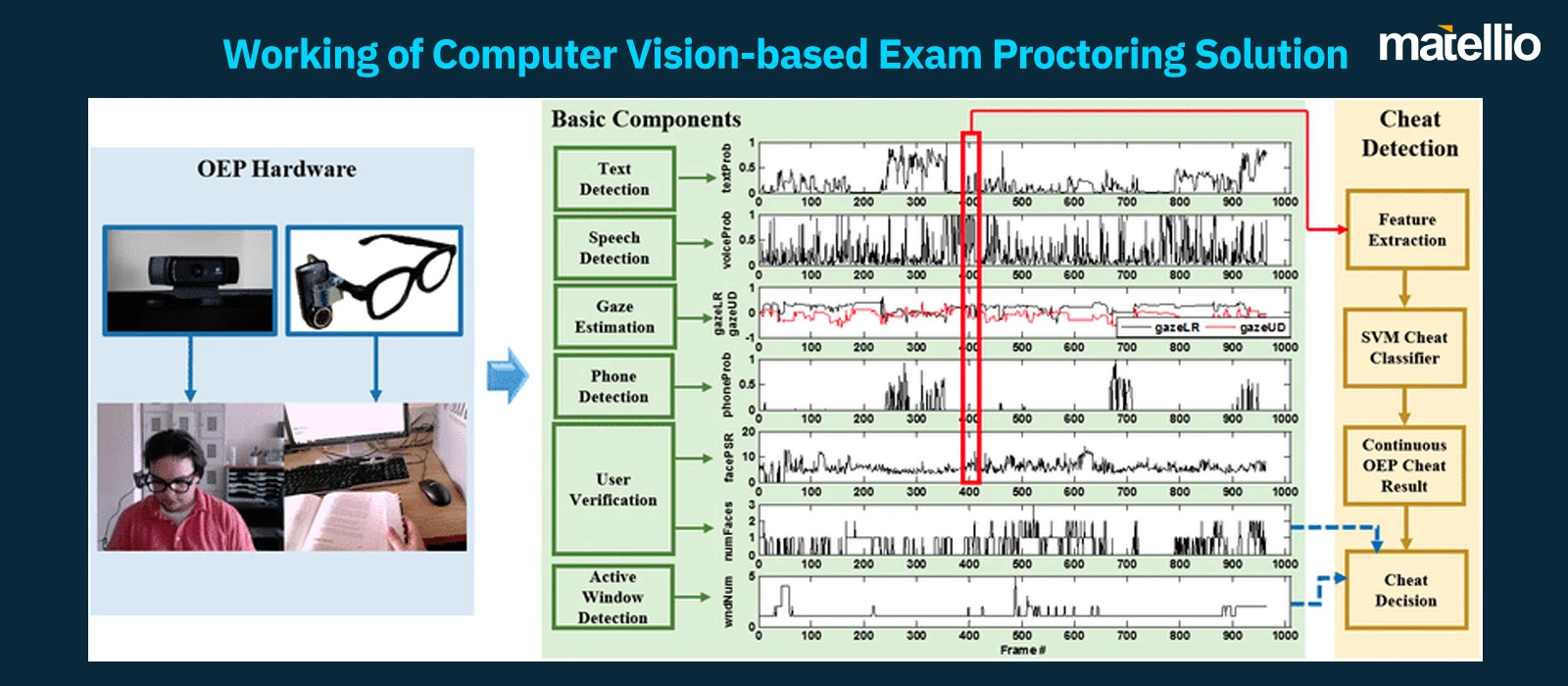 (Source: Research Gate)
(Source: Research Gate)
Integrated via AI eLearning software development, this system ensures fair testing conditions across large populations, without hiring an army of invigilators.
Benefits at a glance:
- Monitor students during exams without human bias
- Detect suspicious behavior like device use or distractions
- Scale proctoring to hundreds or thousands of students
- Maintain exam integrity in both remote and in-person formats
- Reduce the cost and logistics of traditional invigilation
7. Biometric Authentication
Forget ID cards and passwords – computer vision in education enables fast, secure biometric authentication using facial recognition and body metrics like height, posture, or gait.
This is a prime example of how AI integration services and computer vision services create seamless, fraud-proof access to physical and digital spaces. These computer vision applications in education are already cutting down ID misuse and proxy attendance in institutions that care about both security and student experience.
Benefits at a glance:
- Eliminate proxy attendance and ID swapping
- Secure exam access and logins without passwords
- Reduce entry-point bottlenecks across campus
- Ensure only authorized users access secure zones
- Strengthen audit trails for compliance
8. Catching Exam Cheating in Real-Time
Computer vision benefits go beyond convenience—they protect your institution’s credibility. During assessments, AI monitors behavior and facial patterns to flag unusual activity.
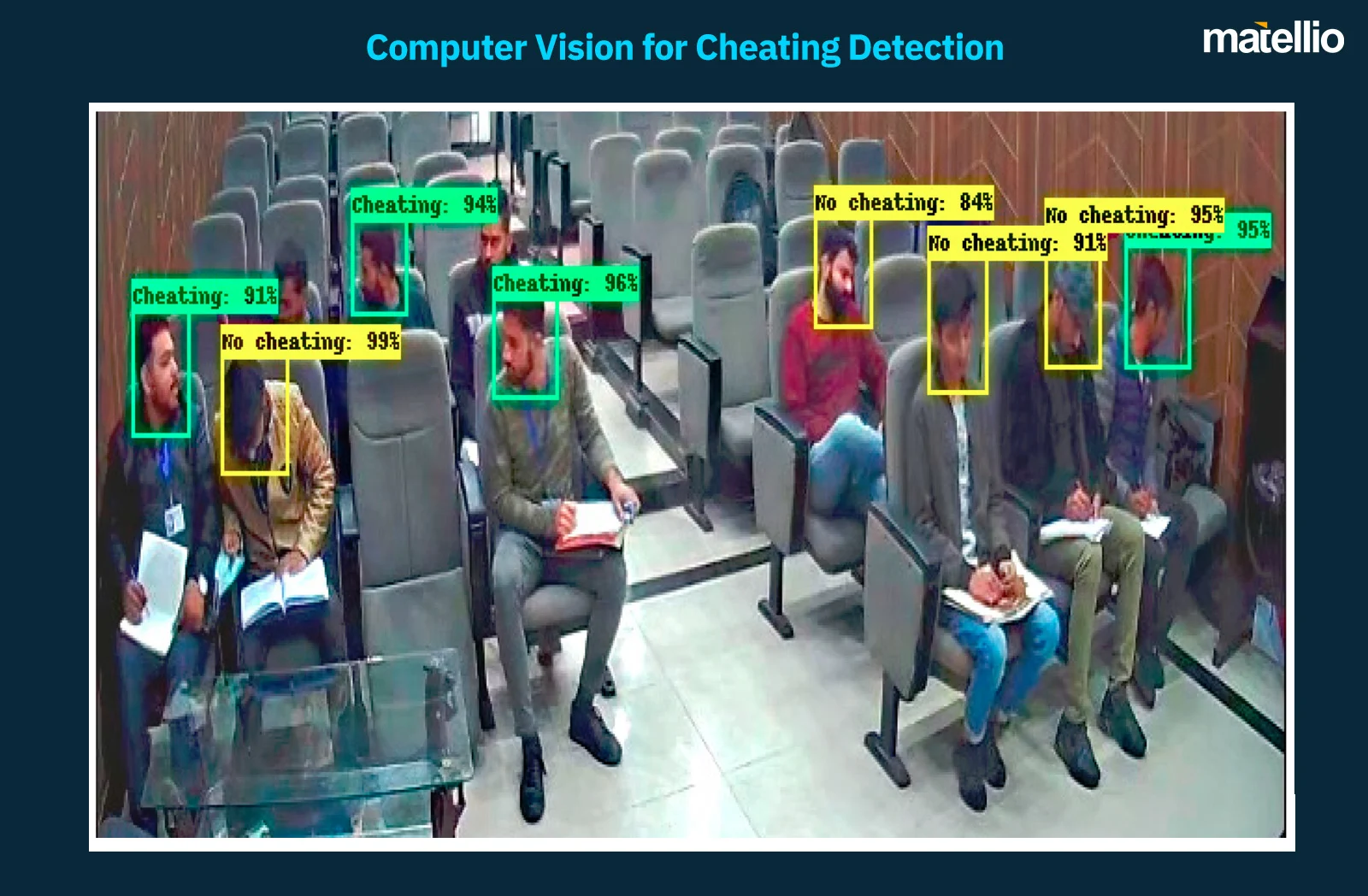 (Source: MDPI)
(Source: MDPI)
When paired with artificial intelligence and machine learning in education, these systems quickly detect cheating indicators like whispering or frequent eye shifts. Institutions using these computer vision applications are drastically reducing academic fraud while maintaining fairness and scalability.
Benefits at a glance:
- Instantly detect cheating behaviors and signals
- Protect institutional integrity at scale
- Reduce false positives through machine learning
- Monitor multiple candidates with zero bias
- Ensure fairness without manual oversight
9. Automated Grading: Turnaround in Minutes, Not Days
Say goodbye to the most time-consulting teacher task! With computer vision applications in education, handwritten papers and scanned answer sheets can be evaluated in minutes.
These tools use AI to assess structure, keywords, or even handwriting. With eLearning software integrations, this is already reducing teacher burnout and giving students faster feedback—one of the underrated benefits of computer vision.
Benefits at a glance:
- Grade assignments in minutes, not hours
- Deliver feedback to students instantly
- Reduce grading bias and fatigue
- Automate reporting to LMS platforms
- Save educators hours of repetitive work
10. Handwriting Recognition & Instant Feedback
Thanks to edtech innovations, modern OCR engines powered by computer vision services now recognize handwritten characters and analyze responses automatically.
Whether it’s recognizing math equations or evaluating written answers, computer vision in education is simplifying grading and response analysis across all levels. When combined with ML model development services, it’s scalable and shockingly accurate.
Benefits at a glance:
- Digitize handwritten tests with AI accuracy
- Automate analysis of diagrams and text
- Enable instant feedback on paper-based work
- Support inclusive, multi-format learning
- Save time for teachers and examiners
Bottom Line?
If your institution is still relying on manual attendance, subjective engagement feedback, or reactive campus security—it’s time to evolve. These computer vision applications in education are not only affordable (thanks to cloud computing and low-cost hardware) but also scalable and proven.
Ready to begin? Schedule a free 30-minute consultation today to connect with our EdTech experts!
How to Implement Computer Vision in Education (the Right Way)
You’ve seen what computer vision in education can do—from real-time engagement tracking to automated proctoring and smart campus security. But turning these ideas into reality? That’s where strategy and execution matter most.
Here’s how institutions are successfully implementing computer vision applications in education, and how you can do it too.
 Define Your Educational Objectives
Define Your Educational Objectives
Before writing a single line of code, define what success looks like for your institution. Do you want to improve student engagement? Enhance exam security? Reduce manual admin? The clearer your goals, the better your eLearning software development company can deliver.
Pro Tip: Reference other successful applications of computer vision in education to differentiate your needs and set a higher benchmark.
 Start Small with an MVP
Start Small with an MVP
A minimum viable product (MVP) helps you test your concept in the real world without burning through your entire budget. Whether it’s a facial recognition-based attendance system or real-time proctoring, an MVP proves feasibility before full rollout.
Build → Test → Learn → Scale. That’s how smart institutions are approaching AI integration services in the education sector.
 Choose the Right Tech Stack
Choose the Right Tech Stack
Your tech stack determines everything—from performance to future flexibility. With computer vision services, this includes real-time video processing, cloud infrastructure, and tools for machine learning in education.
| Category | Technologies / Tools |
| Frontend Frameworks | React.js, Angular, Vue.js |
| Backend Frameworks | Node.js, Django (Python), Spring Boot (Java), Ruby on Rails |
| Computer Vision APIs | OpenCV, Google Cloud Vision API, AWS Rekognition, Mediapipe |
| NLP APIs | OpenAI API, Google NLP API, AWS Comprehend |
| Speech Recognition | Google Speech-to-Text, Amazon Transcribe, Whisper (OpenAI) |
| Data Analytics | Power BI, Tableau, Apache Superset, Google Data Studio |
| Databases | PostgreSQL, MongoDB, Firebase Realtime DB, MySQL |
| Cloud Platforms | AWS, Google Cloud Platform, Microsoft Azure |
| DevOps Tools | Docker, Kubernetes, Jenkins, GitHub Actions, Terraform |
| LMS Integration APIs | Moodle API, Blackboard REST APIs, Canvas LMS APIs |
| Storage Services | AWS S3, Google Cloud Storage, Azure Blob Storage |
Choose technology that supports scalability, cross-platform compatibility, and seamless integration with your LMS or SIS systems.
 Work with a Trusted AI Development Partner
Work with a Trusted AI Development Partner
Here’s the truth: implementing computer vision applications isn’t just about code—it’s about context. From managing camera integrations and data compliance to deploying scalable ML model development services, the process is filled with moving parts. Only a seasoned digital transformation services partner truly understands the benefits of computer vision and the technical hurdles that come with it.
And that’s exactly where Matellio comes in.
Why Matellio Is Your #1 Partner for Computer Vision in Education
You’ve seen what’s possible. Now here’s why Matellio is the best choice to bring it to life. We don’t just offer services—we deliver transformation. Here’s what sets us apart from every other AI integration services provider out there:
Deep Expertise in AI-Powered EdTech
We’ve been building smart, scalable AI eLearning software development solutions for years—long before it was trendy. Our team knows what actually works in education and what’s just buzz.
End-to-End Computer Vision Services
From model training to camera integration and user dashboards, our computer vision services cover every angle. Whether it’s facial recognition for attendance or live exam proctoring, we build it all in-house.
Industry-Grade ML Model Development
Our dedicated experts in ML model development services design systems that don’t just function—they perform. We train, optimize, and deploy models tailored specifically for the education industry.
Enterprise-Level Quality, Startup Agility
We bring the process maturity of a large-scale firm but move fast like a startup. Whether you’re a K-12 institution or an enterprise EdTech platform, we scale to fit your pace and budget.
Custom Solutions, Zero Bloat
No one-size-fits-all templates here. Every solution is built based on your use case, tech ecosystem, and long-term goals—making us a true eLearning software development company, not just a dev shop.
Trusted by Innovators in Education
Our portfolio spans global education platforms, universities, and training organizations. When clients need reliable, future-ready computer vision applications in education, they call Matellio.
Ready to lead your institution into the future with AI? Let’s talk. Schedule a FREE 30-minute consultation right away!
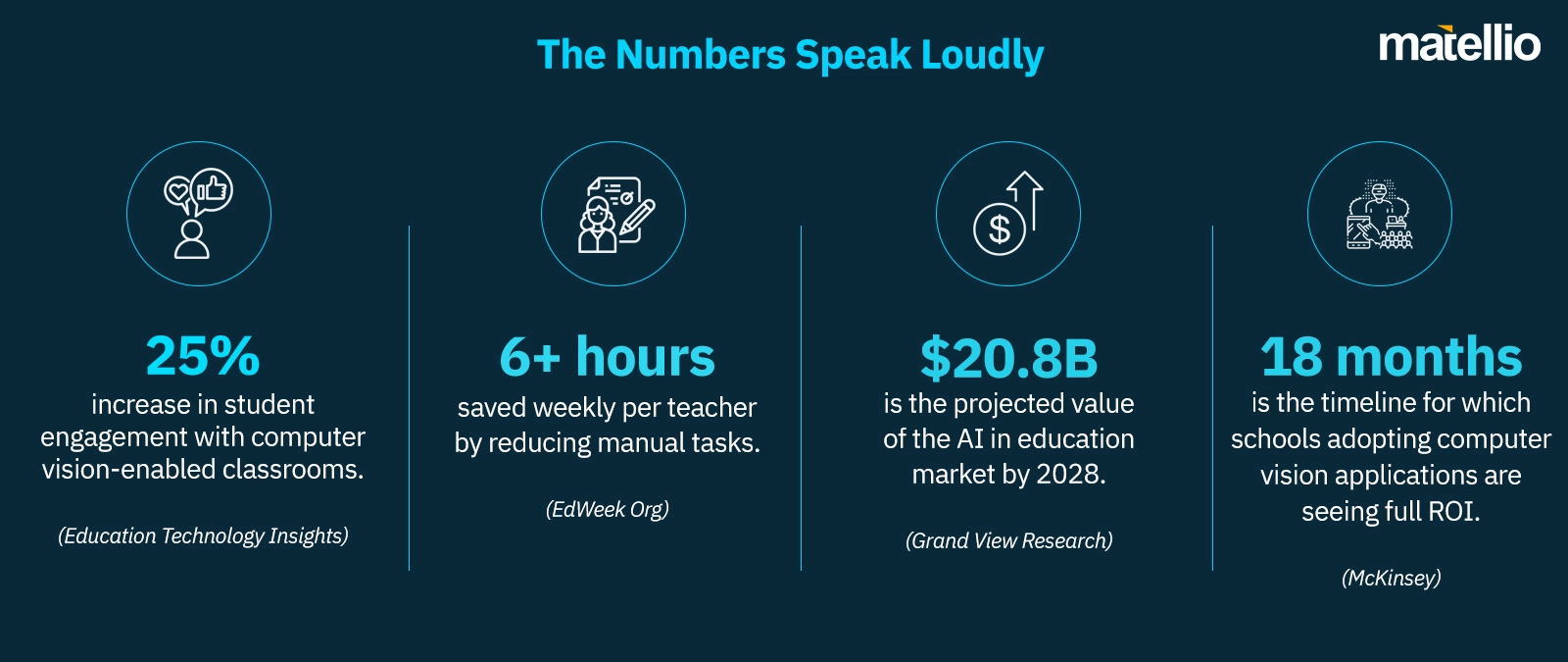
 Define Your Educational Objectives
Define Your Educational Objectives Start Small with an MVP
Start Small with an MVP Choose the Right Tech Stack
Choose the Right Tech Stack Work with a Trusted AI Development Partner
Work with a Trusted AI Development Partner